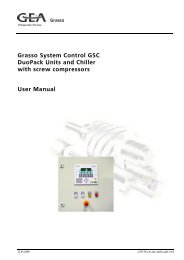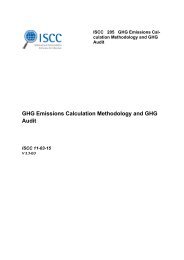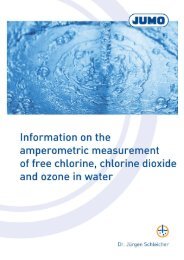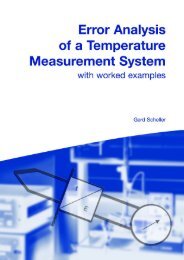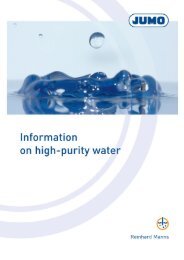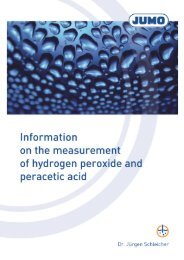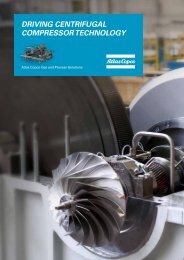FAS622en_pH measurement
Create successful ePaper yourself
Turn your PDF publications into a flip-book with our unique Google optimized e-Paper software.
2 Measurement<br />
Pressure<br />
Pressure has an effect, firstly on the reference system of the reference electrode, and secondly on<br />
the <strong>pH</strong> value. The effect on the reference system can easily be taken into account by choosing a<br />
suitably pressure-resistant electrode. Interpretation difficulties with comparison <strong>measurement</strong>s occur<br />
in certain cases. In waters that contain <strong>pH</strong>-active gases like ammonia, carbon dioxide or hydrogen<br />
sulfide, the pressure changes the <strong>pH</strong> value. In basic solutions, the <strong>pH</strong> value increases with rising<br />
pressure (e. g. NH 3 in water), and in acidic solutions it reduces (e. g. SO 2 in water). If a comparison<br />
<strong>measurement</strong> is made under normal pressure conditions, the <strong>measurement</strong> result is correspondingly<br />
higher or lower. At lower pressures, the effect is often increased as the dissolved gases<br />
effervesce.<br />
Flow<br />
Continuous <strong>measurement</strong>s almost always take place in flowing water. Each electrode reacts more<br />
or less strongly to the water movement. Although brand new electrodes are relatively insensitive to<br />
changes in flow, the effect can cause considerable deviations in measured values with spent electrodes.<br />
Regular checks on the sensitivity to flow provide information on the status of the electrode. If the<br />
sensitivity to flow is too high, the electrode should be replaced.<br />
2.2.3 Installation<br />
Installing the individual components in a systematic manner gives an initial indication of the correct<br />
operation of the electrode.<br />
First of all the transmitter is installed. Testing with a voltage source (<strong>pH</strong> simulator) demonstrates<br />
that it is working correctly.<br />
The next step is to connect the <strong>pH</strong> sensor (sensor with fitting). A comparison <strong>measurement</strong> between<br />
the water in a bucket (or some other ungrounded container) and the intended <strong>measurement</strong><br />
point can give an indication that the sensor is in good condition. The two values must agree, taking<br />
into account the variations with time (decomposition process). The diaphragm and the membrane<br />
must be fully immersed in the water for both <strong>measurement</strong>s.<br />
If this test indicates that there is no fault, connection of the peripheral equipment (recorder, dosing<br />
device, controller, etc.) can start. After each item of equipment is connected, a check should be<br />
made on whether the value indicated by the transmitter has changed significantly.<br />
22 2 Measurement JUMO, FAS 622, Edition 04.07



